check engine BMW X1 SDRIVE28I 2014 User Guide
[x] Cancel search | Manufacturer: BMW, Model Year: 2014, Model line: X1 SDRIVE28I, Model: BMW X1 SDRIVE28I 2014Pages: 295, PDF Size: 7.06 MB
Page 105 of 295
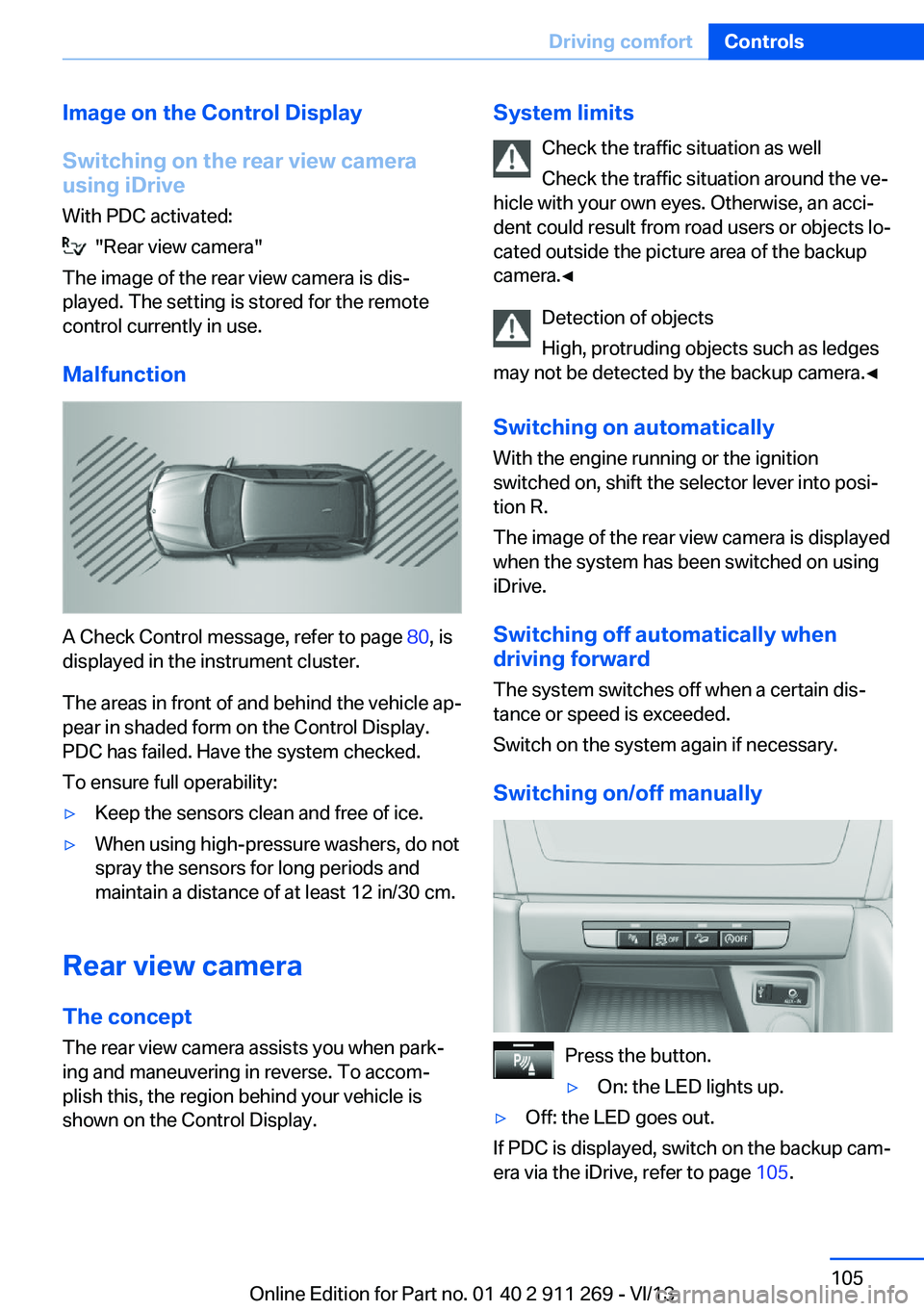
Image on the Control Display
Switching on the rear view camera
using iDrive
With PDC activated:
"Rear view camera"
The image of the rear view camera is disтАР
played. The setting is stored for the remote
control currently in use.
Malfunction
A Check Control message, refer to page 80, is
displayed in the instrument cluster.
The areas in front of and behind the vehicle apтАР
pear in shaded form on the Control Display.
PDC has failed. Have the system checked.
To ensure full operability:
тЦ╖Keep the sensors clean and free of ice.тЦ╖When using high-pressure washers, do not
spray the sensors for long periods and
maintain a distance of at least 12 in/30 cm.
Rear view camera
The concept The rear view camera assists you when parkтАР
ing and maneuvering in reverse. To accomтАР
plish this, the region behind your vehicle is
shown on the Control Display.
System limits
Check the traffic situation as well
Check the traffic situation around the veтАР
hicle with your own eyes. Otherwise, an acciтАР
dent could result from road users or objects loтАР
cated outside the picture area of the backup
camera.тЧА
Detection of objects
High, protruding objects such as ledges
may not be detected by the backup camera.тЧА
Switching on automatically With the engine running or the ignition
switched on, shift the selector lever into posiтАР
tion R.
The image of the rear view camera is displayed
when the system has been switched on using
iDrive.
Switching off automatically when
driving forward
The system switches off when a certain disтАР
tance or speed is exceeded.
Switch on the system again if necessary.
Switching on/off manually
Press the button.
тЦ╖On: the LED lights up.тЦ╖Off: the LED goes out.
If PDC is displayed, switch on the backup camтАР
era via the iDrive, refer to page 105.
Seite 105Driving comfortControls105
Online Edition for Part no. 01 40 2 911 269 - VI/13
Page 137 of 295
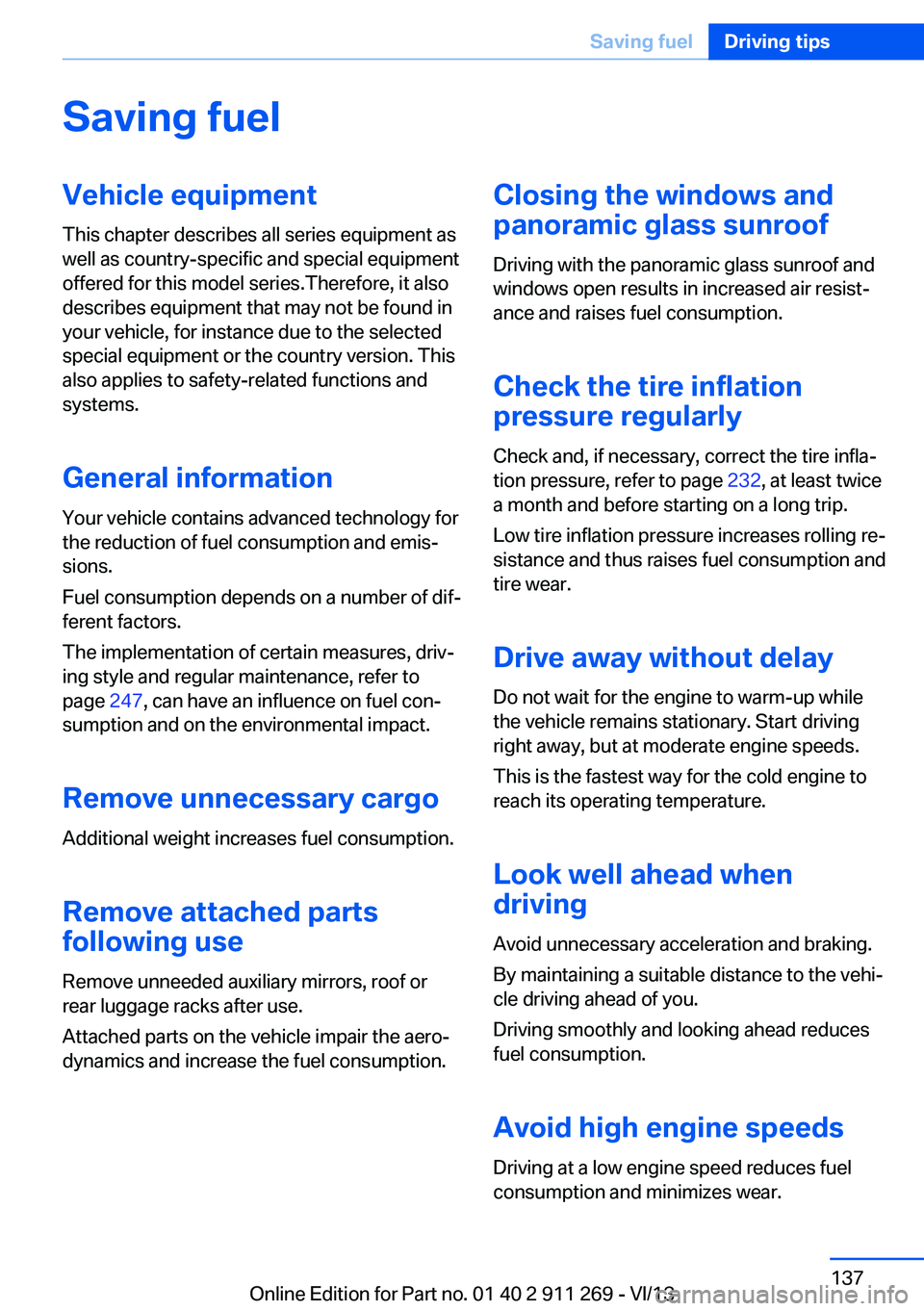
Saving fuelVehicle equipmentThis chapter describes all series equipment as
well as country-specific and special equipment
offered for this model series.Therefore, it also
describes equipment that may not be found in
your vehicle, for instance due to the selected
special equipment or the country version. This
also applies to safety-related functions and
systems.
General information
Your vehicle contains advanced technology for
the reduction of fuel consumption and emisтАР
sions.
Fuel consumption depends on a number of difтАР
ferent factors.
The implementation of certain measures, drivтАР
ing style and regular maintenance, refer to
page 247, can have an influence on fuel conтАР
sumption and on the environmental impact.
Remove unnecessary cargo
Additional weight increases fuel consumption.
Remove attached parts
following use
Remove unneeded auxiliary mirrors, roof or
rear luggage racks after use.
Attached parts on the vehicle impair the aeroтАР
dynamics and increase the fuel consumption.Closing the windows and
panoramic glass sunroof
Driving with the panoramic glass sunroof and
windows open results in increased air resistтАР
ance and raises fuel consumption.
Check the tire inflationpressure regularly
Check and, if necessary, correct the tire inflaтАР
tion pressure, refer to page 232, at least twice
a month and before starting on a long trip.
Low tire inflation pressure increases rolling reтАР
sistance and thus raises fuel consumption and
tire wear.
Drive away without delay
Do not wait for the engine to warm-up while
the vehicle remains stationary. Start driving
right away, but at moderate engine speeds.
This is the fastest way for the cold engine to
reach its operating temperature.
Look well ahead when
driving
Avoid unnecessary acceleration and braking.
By maintaining a suitable distance to the vehiтАР
cle driving ahead of you.
Driving smoothly and looking ahead reduces
fuel consumption.
Avoid high engine speeds
Driving at a low engine speed reduces fuel
consumption and minimizes wear.Seite 137Saving fuelDriving tips137
Online Edition for Part no. 01 40 2 911 269 - VI/13
Page 243 of 295
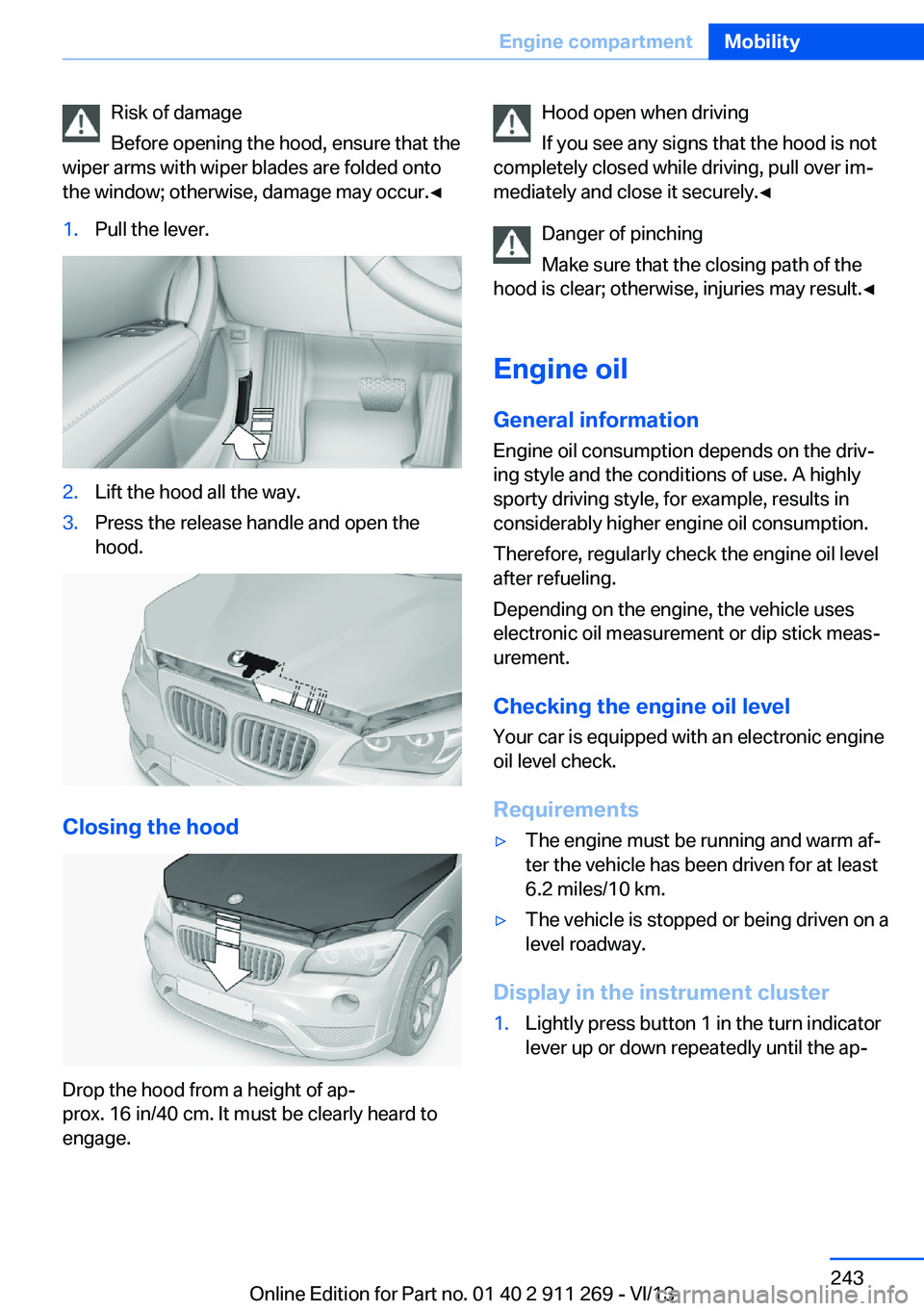
Risk of damage
Before opening the hood, ensure that the
wiper arms with wiper blades are folded onto
the window; otherwise, damage may occur.тЧА1.Pull the lever.2.Lift the hood all the way.3.Press the release handle and open the
hood.
Closing the hood
Drop the hood from a height of apтАР
prox. 16 in/40 cm. It must be clearly heard to
engage.
Hood open when driving
If you see any signs that the hood is not
completely closed while driving, pull over imтАР
mediately and close it securely.тЧА
Danger of pinching
Make sure that the closing path of the
hood is clear; otherwise, injuries may result.тЧА
Engine oil
General information Engine oil consumption depends on the drivтАР
ing style and the conditions of use. A highly
sporty driving style, for example, results in
considerably higher engine oil consumption.
Therefore, regularly check the engine oil level
after refueling.
Depending on the engine, the vehicle uses
electronic oil measurement or dip stick measтАР
urement.
Checking the engine oil level Your car is equipped with an electronic engine
oil level check.
RequirementsтЦ╖The engine must be running and warm afтАР
ter the vehicle has been driven for at least
6.2 miles/10 km.тЦ╖The vehicle is stopped or being driven on a
level roadway.
Display in the instrument cluster
1.Lightly press button 1 in the turn indicator
lever up or down repeatedly until the apтАРSeite 243Engine compartmentMobility243
Online Edition for Part no. 01 40 2 911 269 - VI/13
Page 244 of 295

propriate symbol appears in the display,
accompanied by the word "OIL".2.Press button 2 in the turn indicator lever.
The oil level is checked and the reading
displayed.
Possible displays
SymbolFunctionOil level OK.Oil level is being checked.
This can take about 3 minutes
if the car is at a standstill on a
level surface, or about 5 miтАР
nutes while the car is on the
move.Oil at minimum level:
Add a maximum quantity of
1 US quart/1 liter of engine oil,
refer to page 245, at the next
opportunity.SymbolFunctionOil level is too high.
Overfilling oil damages the enтАР
gine. Have the vehicle
checked immediately.The oil level sensor is defecтАР
tive.
Do not add engine oil.
It is possible to continue drivтАР
ing. Note the newly calculated
remaining mileage until the
next oil service, refer to
page 78. Have the system
checked as soon as possible.
Display via iDrive
1."Vehicle Info"2."Vehicle status"3. "Engine oil level"
Possible messages
тЦ╖"Engine oil level OK"тЦ╖"Measurement not possible at this time."тЦ╖"Measuring engine oil level..."
Duration with the engine running: apтАР
prox. 3 minutes.
Duration while driving: approx. 5 minutes.
If engine oil was added, it may take up to
30 minutes to obtain an oil level reading.тЦ╖"Engine oil level below minimum. Add 1
quart!"Seite 244MobilityEngine compartment244
Online Edition for Part no. 01 40 2 911 269 - VI/13
Page 245 of 295

Add a maximum quantity of 1 US quart/1 liтАР
ter of engine oil at the next opportunity, reтАР
fer also to Adding engine oil below.тЦ╖"Engine oil level too high! Have this
checked."
Too much engine oil
Have the vehicle checked immediтАР
ately; otherwise, surplus oil can lead to enтАР
gine damage.тЧАтЦ╖"Measurement inactive. Have this
checked." Do not add engine oil. It is possiтАР
ble to continue driving. Note the newly calтАР
culated remaining mileage until the next oil
service, refer to page 78. Have the system
checked as soon as possible.
Adding engine oil
Filler neck
Add a maximum quantity of 1 US quart/1 liter
of oil only after a corresponding message apтАР
pears on the Control Display.
Add oil promptly
Add oil within the next 125 miles/200 km;
otherwise, engine damage could result.тЧА
Too much engine oil
Have the vehicle checked immediately;
otherwise, surplus oil can lead to engine damтАР
age.тЧА
Protect children
Keep oil, grease, etc., out of reach of chilтАР
dren and heed the warnings on the containers
to prevent health risks.тЧА
Oil types for refilling
Notes No oil additives
Do not use oil additives as these may
cause engine damage.тЧА
Viscosity classes of engine oils
When selecting an engine oil, ensure that
the engine oil belongs to one of the SAE visтАР
cosity classes 0W-40, 0W-30, 5W-40, or
5W-30, or malfunctions or engine damage may
occur.тЧА
The engine oil quality is critical for the life of
the engine.
Due to national regulations, some oil types are
not available in every country.
Approved oil typesGasoline engineBMW High Performance SAE 5W-30BMW Longlife-01BMW Longlife-01 FE
Further information on approved oil types can
be obtained from the service center.
Alternative oil types If the approved engine oils are not available, up
to 1 US quart/liter of an oil with the following
specification can be used:
Gasoline engineAPI SM or a higher quality standardSeite 245Engine compartmentMobility245
Online Edition for Part no. 01 40 2 911 269 - VI/13
Page 246 of 295

Oil changeAn oil change should be carried out by the
service center only.
Coolant
General information Danger of burns from hot engine
Do not open the cooling system while
the engine is hot; otherwise, escaping coolant
may cause burns.тЧА
Suitable additives
Only use suitable additives; otherwise,
engine damage may occur. The additives are
harmful to your health.тЧА
Coolant consists of water and additives.
Not all commercially available additives are
suitable for your vehicle. Ask your service cenтАР
ter for suitable additives.
Checking the coolant level
1.Do not open the hood until the engine has
cooled down.2.Turn the expansion tank cap counterclockтАР
wise slightly to allow any accumulatedpressure to escape; then continue turning
to open.3.The filling level indicator 1 in the filler neck
indicates the coolant level. The coolant
level is correct if it is between the arrows of
the respective reservoir label 2.4.If the coolant is low, slowly add coolant up
to the specified level; do not overfill.5.Turn the cap until there is an audible click.6.Have the cause of the coolant loss elimiтАР
nated as soon as possible.
Disposal
Comply with the appropriate environтАР
mental protection regulations when disтАР
posing of coolant additives.
Seite 246MobilityEngine compartment246
Online Edition for Part no. 01 40 2 911 269 - VI/13
Page 247 of 295
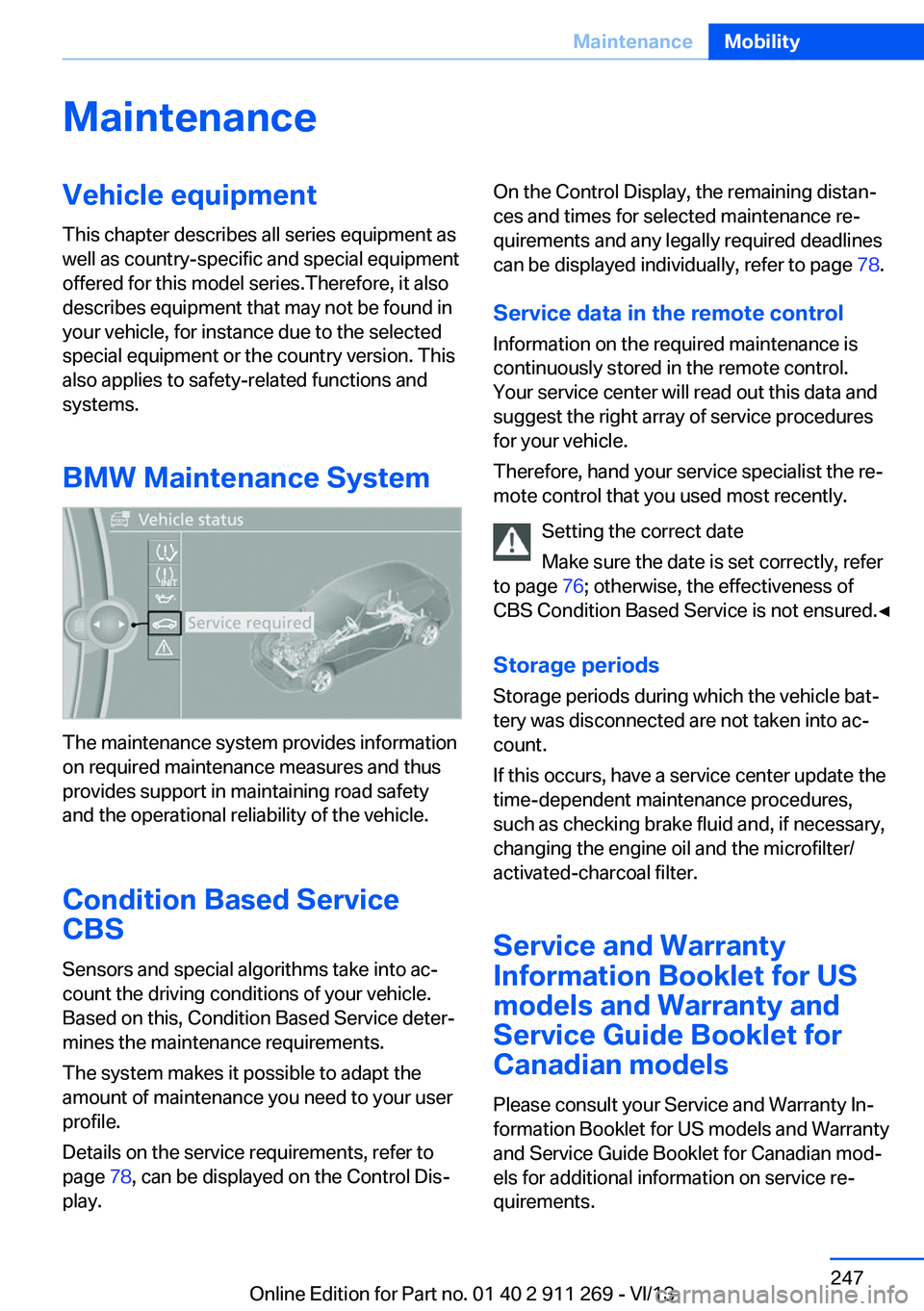
MaintenanceVehicle equipment
This chapter describes all series equipment as
well as country-specific and special equipment
offered for this model series.Therefore, it also
describes equipment that may not be found in
your vehicle, for instance due to the selected
special equipment or the country version. This
also applies to safety-related functions and
systems.
BMW Maintenance System
The maintenance system provides information
on required maintenance measures and thus
provides support in maintaining road safety
and the operational reliability of the vehicle.
Condition Based Service
CBS
Sensors and special algorithms take into acтАР
count the driving conditions of your vehicle.
Based on this, Condition Based Service deterтАР
mines the maintenance requirements.
The system makes it possible to adapt the
amount of maintenance you need to your user
profile.
Details on the service requirements, refer to
page 78, can be displayed on the Control DisтАР
play.
On the Control Display, the remaining distanтАР
ces and times for selected maintenance reтАР
quirements and any legally required deadlines
can be displayed individually, refer to page 78.
Service data in the remote control Information on the required maintenance is
continuously stored in the remote control. Your service center will read out this data and
suggest the right array of service procedures
for your vehicle.
Therefore, hand your service specialist the reтАР
mote control that you used most recently.
Setting the correct date
Make sure the date is set correctly, refer
to page 76; otherwise, the effectiveness of
CBS Condition Based Service is not ensured.тЧА
Storage periods Storage periods during which the vehicle batтАР
tery was disconnected are not taken into acтАР
count.
If this occurs, have a service center update the
time-dependent maintenance procedures,
such as checking brake fluid and, if necessary,
changing the engine oil and the microfilter/
activated-charcoal filter.
Service and Warranty
Information Booklet for US
models and Warranty and
Service Guide Booklet for Canadian models
Please consult your Service and Warranty InтАР
formation Booklet for US models and Warranty
and Service Guide Booklet for Canadian modтАР
els for additional information on service reтАР
quirements.Seite 247MaintenanceMobility247
Online Edition for Part no. 01 40 2 911 269 - VI/13
Page 248 of 295
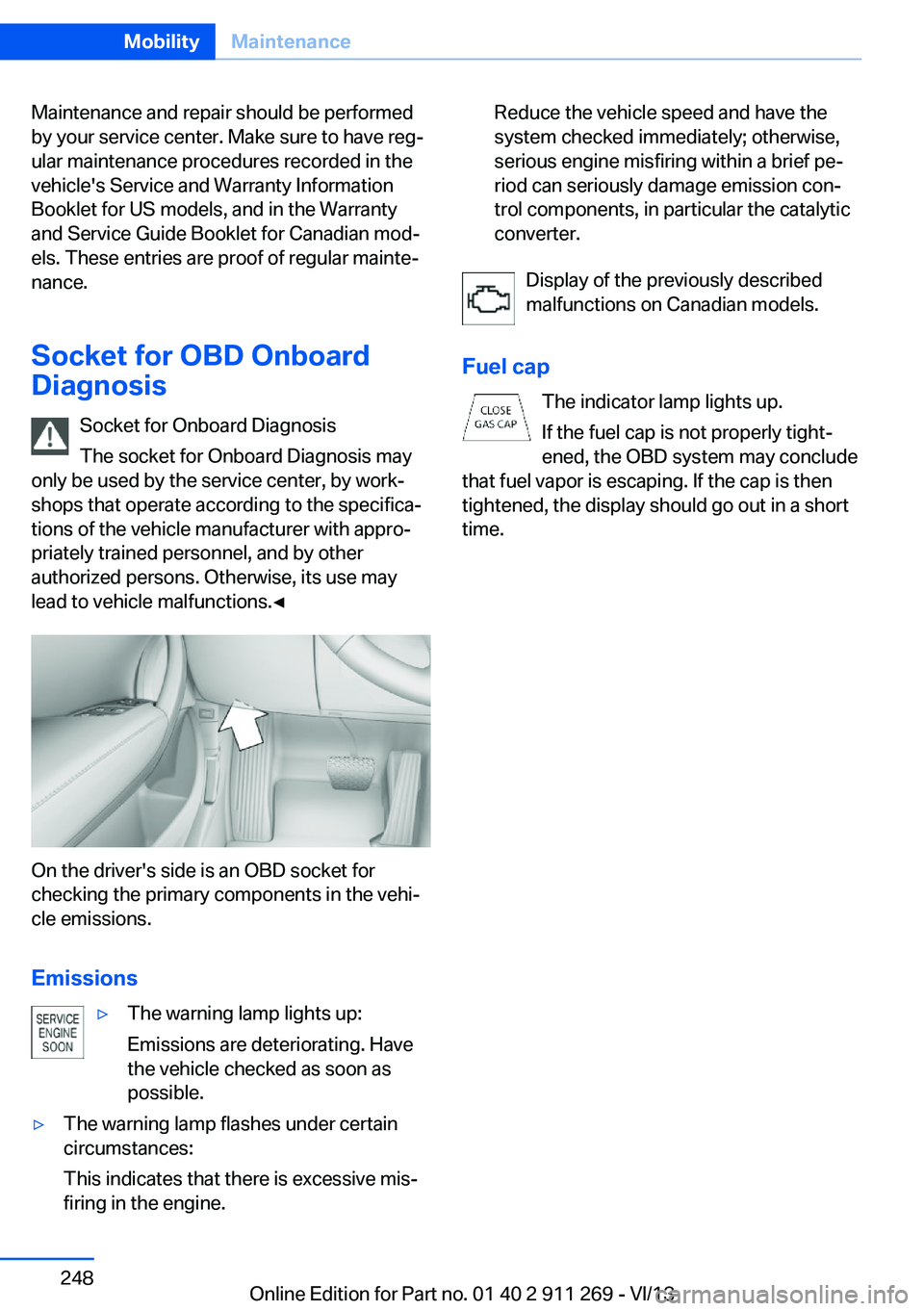
Maintenance and repair should be performed
by your service center. Make sure to have regтАР
ular maintenance procedures recorded in the
vehicle's Service and Warranty Information
Booklet for US models, and in the Warranty
and Service Guide Booklet for Canadian modтАР
els. These entries are proof of regular mainteтАР
nance.
Socket for OBD Onboard
Diagnosis
Socket for Onboard Diagnosis
The socket for Onboard Diagnosis may
only be used by the service center, by workтАР
shops that operate according to the specificaтАР
tions of the vehicle manufacturer with approтАР
priately trained personnel, and by other
authorized persons. Otherwise, its use may
lead to vehicle malfunctions.тЧА
On the driver's side is an OBD socket for
checking the primary components in the vehiтАР
cle emissions.
Emissions
тЦ╖The warning lamp lights up:
Emissions are deteriorating. Have
the vehicle checked as soon as
possible.тЦ╖The warning lamp flashes under certain
circumstances:
This indicates that there is excessive misтАР
firing in the engine.Reduce the vehicle speed and have the
system checked immediately; otherwise,
serious engine misfiring within a brief peтАР
riod can seriously damage emission conтАР
trol components, in particular the catalytic
converter.
Display of the previously described
malfunctions on Canadian models.
Fuel cap The indicator lamp lights up.
If the fuel cap is not properly tightтАР
ened, the OBD system may conclude
that fuel vapor is escaping. If the cap is then
tightened, the display should go out in a short
time.
Seite 248MobilityMaintenance248
Online Edition for Part no. 01 40 2 911 269 - VI/13
Page 255 of 295
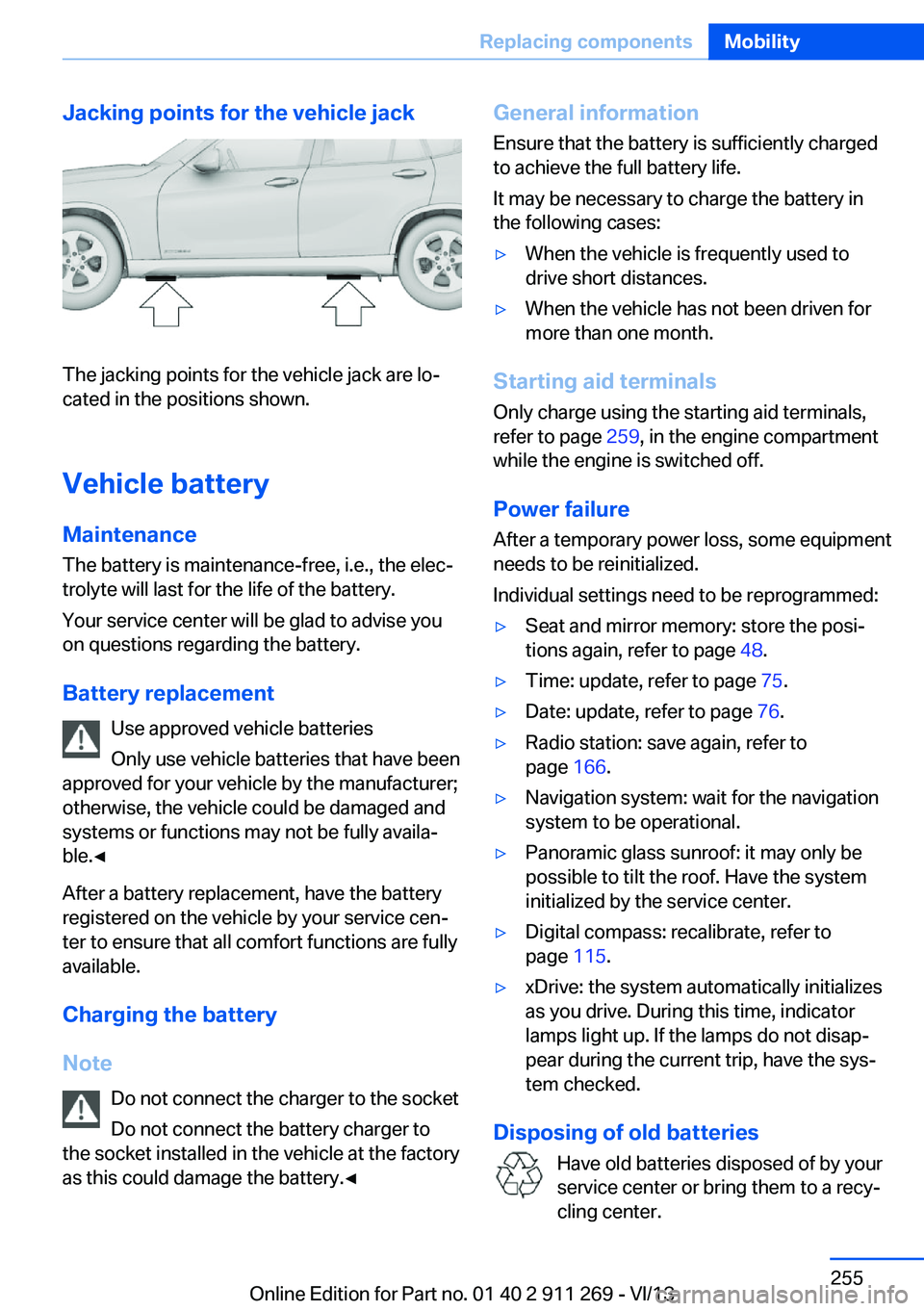
Jacking points for the vehicle jack
The jacking points for the vehicle jack are loтАР
cated in the positions shown.
Vehicle battery
Maintenance
The battery is maintenance-free, i.e., the elecтАР trolyte will last for the life of the battery.
Your service center will be glad to advise you
on questions regarding the battery.
Battery replacement Use approved vehicle batteries
Only use vehicle batteries that have been
approved for your vehicle by the manufacturer;
otherwise, the vehicle could be damaged and
systems or functions may not be fully availaтАР
ble.тЧА
After a battery replacement, have the battery
registered on the vehicle by your service cenтАР
ter to ensure that all comfort functions are fully
available.
Charging the battery
Note Do not connect the charger to the socket
Do not connect the battery charger to
the socket installed in the vehicle at the factory
as this could damage the battery.тЧА
General information
Ensure that the battery is sufficiently charged
to achieve the full battery life.
It may be necessary to charge the battery in
the following cases:тЦ╖When the vehicle is frequently used to
drive short distances.тЦ╖When the vehicle has not been driven for
more than one month.
Starting aid terminals
Only charge using the starting aid terminals,
refer to page 259, in the engine compartment
while the engine is switched off.
Power failure
After a temporary power loss, some equipment
needs to be reinitialized.
Individual settings need to be reprogrammed:
тЦ╖Seat and mirror memory: store the posiтАР
tions again, refer to page 48.тЦ╖Time: update, refer to page 75.тЦ╖Date: update, refer to page 76.тЦ╖Radio station: save again, refer to
page 166.тЦ╖Navigation system: wait for the navigation
system to be operational.тЦ╖Panoramic glass sunroof: it may only be
possible to tilt the roof. Have the system
initialized by the service center.тЦ╖Digital compass: recalibrate, refer to
page 115.тЦ╖xDrive: the system automatically initializes
as you drive. During this time, indicator
lamps light up. If the lamps do not disapтАР
pear during the current trip, have the sysтАР
tem checked.
Disposing of old batteries
Have old batteries disposed of by your
service center or bring them to a recyтАР
cling center.
Seite 255Replacing componentsMobility255
Online Edition for Part no. 01 40 2 911 269 - VI/13
Page 258 of 295

For this purpose, data that are used to deтАР
termine the necessary rescue measures,
such as the current position of the vehicle
if it can be established, are transmitted to
the BMW Response Center.тЦ╖If the LED is flashing but the BMW ReтАР
sponse Center cannot be heard on the
hands-free system, the hands-free system
may be malfunctioning. However, the
BMW Response Center may still be able to
hear you.
Initiating an Emergency Request
automatically
Under certain conditions, an Emergency ReтАР
quest is automatically initiated immediately afтАР
ter a severe accident. Automatic Collision NotiтАР
fication is not affected by pressing the SOS
button.
Roadside Assistance
Service availability Roadside Assistance can be reached around
the clock in many countries. You can obtain asтАР
sistance there in the event of a vehicle breakтАР
down.
Roadside Assistance The Roadside Assistance, refer to page 221,
phone number can be viewed on the iDrive or a
connection to Roadside Assistance can be esтАР
tablished directly.
Warning triangle
On the inside of the tailgate. To remove, press
on the tab, arrow.
First aid kit
The first aid kit is located in a storage compartтАР
ment on the right side in the cargo area.
Some of the articles contained in the first aid
pouch have a limited service life.
Check the expiration dates of the contents
regularly and replace any items promptly.
Jump-starting
Notes If the battery is discharged, an engine can be
started using the battery of another vehicle
and two jumper cables. Only use jumper caтАР
bles with fully insulated clamp handles.
To prevent personal injury or damage to both
vehicles, adhere strictly to the following proceтАР
dure.
Seite 258MobilityBreakdown assistance258
Online Edition for Part no. 01 40 2 911 269 - VI/13